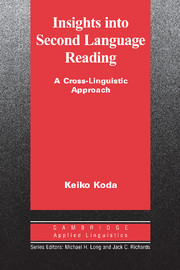Book contents
- Frontmatter
- Contents
- Tables and figures
- Series editors' preface
- Foreword
- Acknowledgments
- I THEORETICAL FOUNDATIONS
- II ESSENTIAL COMPONENTS
- 3 Word recognition
- 4 Vocabulary knowledge
- 5 Intraword awareness and word-knowledge development
- 6 Information integration in sentence processing
- 7 Discourse processing
- 8 Text structure and comprehension
- III LOOKING AT THE WHOLE
- IV THEORY INTO PRACTICE
- References
3 - Word recognition
Published online by Cambridge University Press: 05 October 2012
- Frontmatter
- Contents
- Tables and figures
- Series editors' preface
- Foreword
- Acknowledgments
- I THEORETICAL FOUNDATIONS
- II ESSENTIAL COMPONENTS
- 3 Word recognition
- 4 Vocabulary knowledge
- 5 Intraword awareness and word-knowledge development
- 6 Information integration in sentence processing
- 7 Discourse processing
- 8 Text structure and comprehension
- III LOOKING AT THE WHOLE
- IV THEORY INTO PRACTICE
- References
Summary
Word recognition refers to the processes of extracting lexical information from graphic displays of words. Individual words are critical building blocks in text-meaning construction, and efficiency in converting graphic symbols into sound, or meaning, information is indispensable in comprehension. Consequently, how this competence develops is a chief concern among researchers. Word recognition has attracted the attention of psychologists as well, because words are the ideal unit for analysis in the study of cognition. Words can readily be segmented into their constituents at multiple levels – such as graphemes, phonemes, and morphemes – and therefore allow systematic investigations of how language is represented in the mind (Balota, 1994). A multitude of studies with both children and adults have tackled the core issue in word recognition: how information, “packaged” in a word, is perceived, extracted, sorted, and retrieved.
Building on the accumulated findings from L1 word-recognition research, this chapter explores systematic variations in visualinformation extraction among L1 and L2 readers. By way of background, the chapter begins with an explanation of how word-recognition efficiency facilitates text comprehension. Three component operations are described: orthographic, phonological, and semantic processing. Then, using subsequent cross-linguistic comparisons of word-recognition procedures as a footing, major characteristics of word-recognition behaviors among L2 readers are discussed. Although the terms word recognition and decoding are often used interchangeably in other chapters, here, word recognition refers to the processes of obtaining words' sounds and meanings, and decoding deals specifically with the extraction of phonological information.
- Type
- Chapter
- Information
- Insights into Second Language ReadingA Cross-Linguistic Approach, pp. 29 - 47Publisher: Cambridge University PressPrint publication year: 2005
- 1
- Cited by



